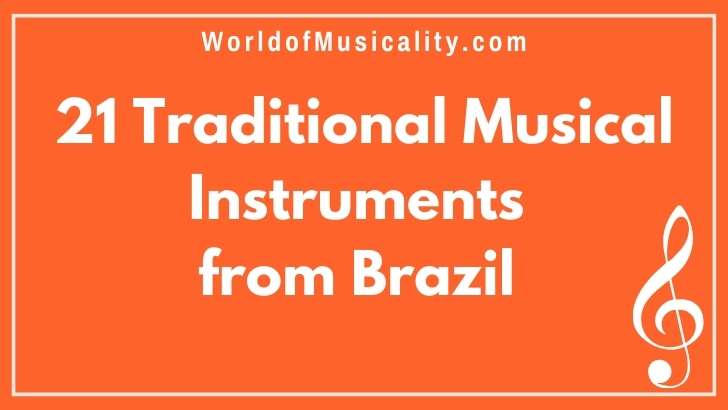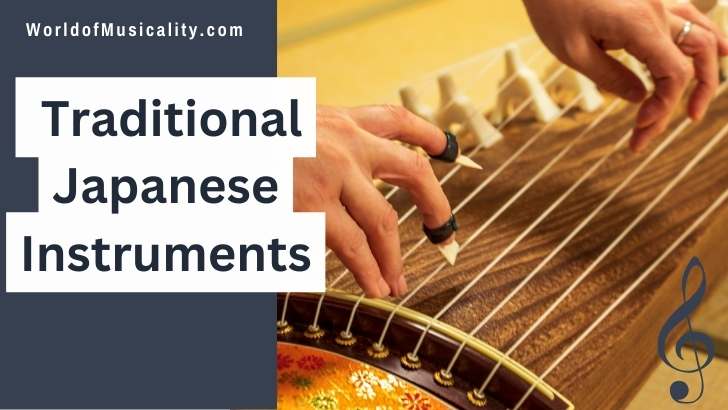
Traditional Japanese musical instruments, or “wagakki,” have been a cornerstone of Japan’s cultural identity from ancient through to modern times.
Deeply intertwined with various aspects of Japanese life, including religious ceremonies, theatrical arts, and daily entertainment, Japanese traditional instruments are not only celebrated for their unique sounds and craftsmanship but also for their cultural significance.
In this article, we will explore a selection of these traditional string, wind and percussion instruments, discussing how they are crafted, the unique techniques required to play them, and some of the influential musicians who have mastered them.
Japanese String Instruments
1. Koto
A long, zither-like instrument with 13 strings stretched over movable bridges, played by plucking the strings with picks on the fingers.
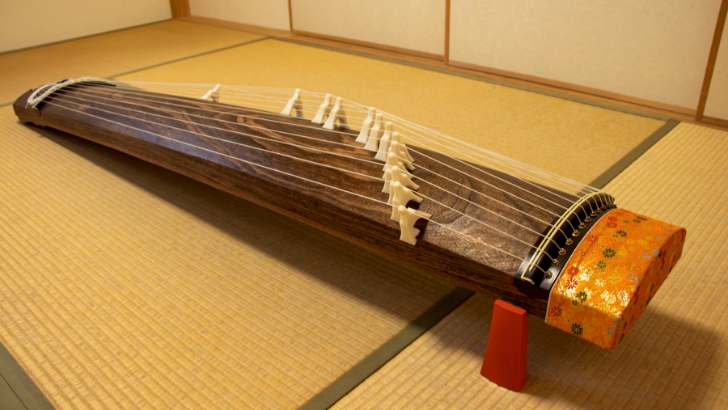
The Koto is a traditional Japanese string instrument that resembles a large wooden zither. It is typically about 71 inches long and made primarily from kiri wood (Paulownia tomentosa). The koto features 13 strings made of silk or nylon, which are stretched across movable bridges that can be adjusted to change the pitch of the strings.
When played, the koto produces a resonant, melodious sound that can vary from bright and percussive to soft and flowing, depending on the playing technique. It is traditionally played using small picks worn on the fingers of the right hand, while the left hand may press the strings to the left of the bridges to alter the pitch and create vibrato effects.
The koto’s history dates back to the 8th century when it was introduced from China as part of the cultural exchange along the Silk Road. Over time, it became a staple in Japanese court music and has since played a significant role in traditional Japanese culture. The koto was traditionally played by women, particularly in the noble courts, and it continues to be a symbol of refined and classical Japanese music.
One of the most significant musicians associated with the koto is Yatsuhashi Kengyo, who lived in the 17th century and is often called the “Father of Modern Koto.” He developed new techniques and compositions that have shaped the way the instrument is played today.
2. Shamisen
A three-stringed, banjo-like instrument played with a large plectrum, known for its distinct, sharp sound.
The Shamisen is a three-stringed instrument from Japan that resembles a banjo. It has a long, slender neck and a rectangular body covered with animal skin, usually cat or dog, which gives it a distinct, resonant tone. The strings are typically made of silk or nylon and are played with a large, triangular plectrum called a “bachi.”
The sound of the shamisen can vary from sharp and percussive to mellow and melodic, depending on the playing style and the type of shamisen. It is known for its expressive dynamics and is a staple in many forms of Japanese music, from the dramatic narratives of kabuki theater to the storytelling min’yō folk music.
Introduced to Japan in the 16th century from the Ryukyu Islands (modern-day Okinawa), the instrument quickly became popular in various cultural practices. It adapted over time, integrating itself into different musical genres and performances, including geisha entertainment and bunraku puppet theater.
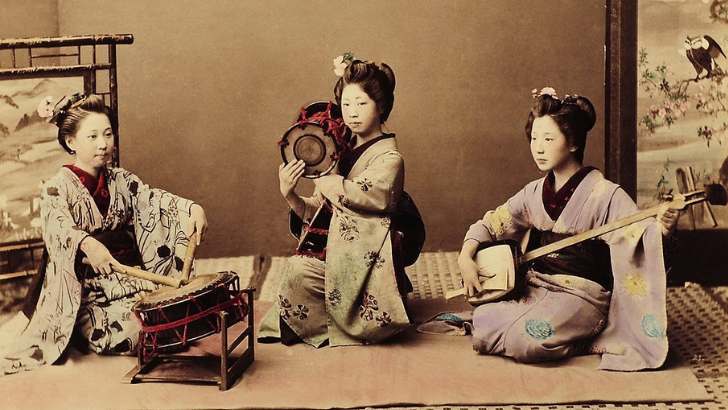
One significant musician who specialized in the shamisen was Katsuhiro Kineya. He was renowned for his mastery in nagauta, a style of music accompanying kabuki theater. His performances and teachings have left a lasting impact on the tradition of shamisen playing in Japan.
3. Biwa
A pear-shaped lute with four to five strings, traditionally used in narrative storytelling and Buddhist chanting.
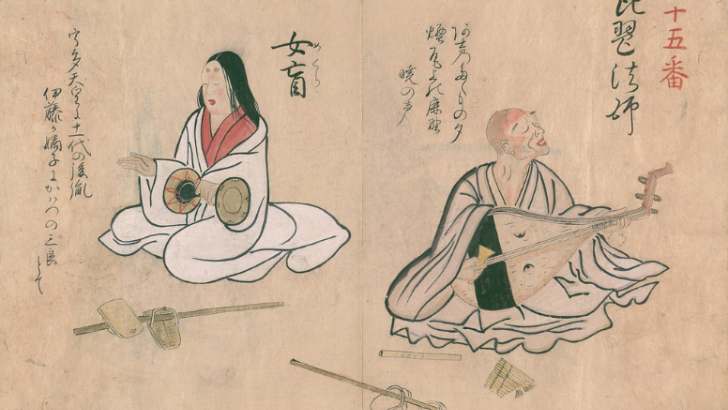
The Biwa is a Japanese stringed instrument with a distinctive pear-shaped body, resembling a lute. It typically has four to five strings and a short fretted neck. The body of the biwa is made from wood, often mulberry or Japanese cherry, while the strings were traditionally made from silk, though modern versions may use nylon.
The sound of the biwa is deep and resonant, capable of producing a range of emotional expressions, from melancholic tones to more vibrant, rhythmic sounds. It is played with a large, wedge-shaped plectrum, striking the strings in a manner that allows for dynamic storytelling and musical articulation.
Historically, the biwa came to Japan from China during the Nara period (710-794 AD) and became particularly popular in the Heian period (794-1185 AD). It was often used in court music and for accompanying epic tales and Buddhist chants. Over time, the biwa found its role in various aspects of Japanese culture, including the narrative recitation of the “Tale of the Heike,” a medieval war tale.
One notable musician who played the biwa was the blind priest Shaku Hachi, known for his skillful performances of the “Tale of the Heike.” His mastery helped elevate the biwa’s status in Japanese musical and cultural history.
4. Sanshin
Similar to the shamisen but smaller, with a snakeskin-covered body, commonly used in Okinawan music.
The Sanshin is a string instrument originating from the Okinawa region of Japan. It closely resembles the shamisen but is distinguished by its smaller size and the use of snakeskin to cover its rounded body. The neck of the sanshin is made from ebony or other hardwoods, and it typically has three strings made of silk or nylon.
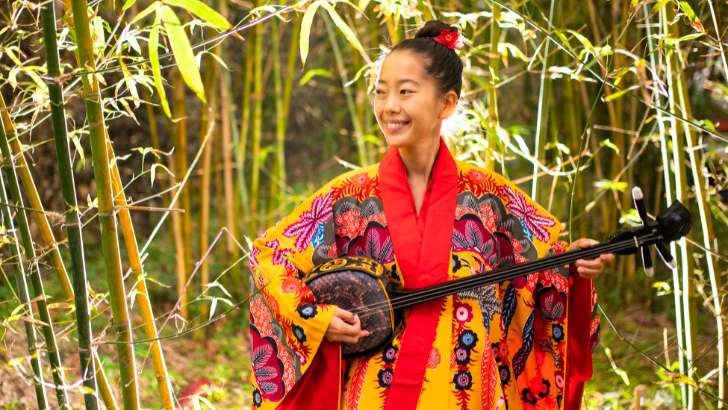
The sound of the sanshin is distinctively mellower compared to the shamisen, producing a warm, resonant tone that is central to Okinawan music. It is often played with a small pick, and the music it creates is integral to both folk and classical Ryukyuan performances.
The sanshin’s history can be traced back to the 15th century, influenced by similar instruments from China and Southeast Asia. It played a crucial role in the court music of the Ryukyu Kingdom before becoming a popular folk instrument among the common people. Today, the sanshin remains a symbol of Okinawan identity and cultural pride, featured in both traditional ceremonies and modern music festivals.
One of the most celebrated sanshin players is Rinsho Kadekaru, who was instrumental in popularizing Okinawan music in Japan. His performances and recordings have helped to preserve and rejuvenate interest in this unique instrument.
5. Ichigenkin
A single-stringed zither played with a sliding bridge under the string and a metal rod to press the string.
The Ichigenkin is a unique and simple traditional Japanese string instrument. It consists of just one silk string stretched over a slender, wooden soundboard. The body of the instrument is usually made from a light wood such as paulownia or kiri, chosen for its resonant qualities. The ichigenkin is played using a small, ivory or bamboo plectrum and a metal or ivory rod called a “press” to create pitches.
The sound produced by the ichigenkin is delicate and ethereal, capable of producing haunting melodies with a very intimate feel. It is often described as meditative and introspective, suitable for solo performances that focus on spiritual or reflective music.
The ichigenkin’s history in Japan dates back to the Edo period (1603-1868), where it was primarily used in the practice of Zen Buddhism as an aid to meditation. Its playing style and musical expression are closely tied to the concepts of simplicity and minimalism, reflective of Zen principles.
Although not as widely recognized as other traditional instruments like the koto or shamisen, notable musicians such as Issui Minegishi have been known for their skill with the ichigenkin. Minegishi is a modern exponent of the instrument, dedicated to preserving and promoting its unique musical tradition.
6. Taishogoto
Has strings stretched over a long box and is played by pressing keys to change pitches.
The Taishogoto, also known as the Nagoya harp, is a unique Japanese string instrument that combines features of a typewriter and a harp. It consists of a long, narrow wooden box with strings stretched across it, similar to a lap steel guitar. The strings are typically made of steel, and the instrument includes keys like a piano, which are pressed to change the pitch of the strings.
The sound of the taishogoto is bright and melodious, akin to a harp or a mandolin, with a clear, ringing tone that carries well. It is played by strumming or plucking the strings while pressing the keys to create different notes and melodies.
The taishogoto was invented in the early 20th century by Gorō Morita in Nagoya, Japan. It was named after the Taishō era (1912-1926) to mark its modern and innovative design during a time of great cultural change in Japan. The instrument quickly gained popularity for its ease of play and its versatility in various musical genres, from traditional Japanese music to modern pop and folk songs.
While the taishogoto does not have as many famous players as some other traditional Japanese instruments, its accessibility has made it popular among music enthusiasts and educators, particularly for those beginning to explore the world of music.
7. Tonkori
A plucked string instrument from the Ainu culture of northern Japan, typically with five strings.
The Tonkori is a traditional string instrument from the Ainu culture of northern Japan and parts of Russia. It has a slender, elongated body made primarily from a single piece of wood, often spruce or pine, and typically features five strings, which are plucked with the fingers. The strings themselves are traditionally made from twisted tree bark or plant fibers, though modern versions may use metal or synthetic materials.
The sound of the tonkori is unique and somewhat stark, characterized by a repetitive, rhythmic melody that complements the oral traditions and ceremonial songs of the Ainu people. Its music is often reflective, embodying the natural landscapes and spiritual beliefs of its indigenous players.
Historically, the tonkori was used in ritualistic performances and social gatherings but was at risk of becoming extinct as fewer people learned to play it. Recently, there has been a revival of interest in Ainu culture and music, leading to a resurgence in the instrument’s popularity.
One significant musician in the revival of the tonkori is Oki Kano, an Ainu-Japanese musician who has gained international acclaim. He has been pivotal in bringing the tonkori to global audiences, integrating its sound with different musical genres and raising awareness of Ainu musical heritage.
8. Kokyu
A bowed instrument similar to a shamisen but played with a bow, it has a soft, gentle sound.
The Kokyu is a traditional string instrument similar in appearance to the shamisen but played with a bow. It features a small, hollow body typically made from wood and covered with cat or dog skin, which amplifies the sound. The kokyu has three silk strings that are played using a horsehair bow, much like a violin.
The sound of the kokyu is delicate and expressive, capable of producing a range of emotional tones from melancholic to joyful. Its sound is softer and more intimate compared to other traditional Japanese string instruments, making it well-suited for smaller, more personal performances.
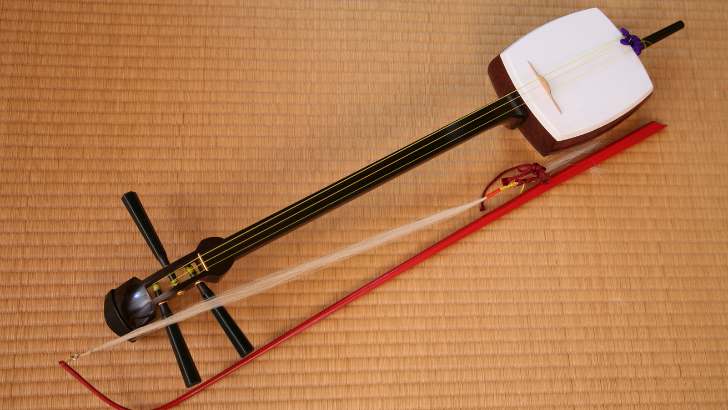
The kokyu’s origins are somewhat unclear, but it is believed to have been developed during the Edo period (1603-1868). It has traditionally been used in nagauta music, which accompanies kabuki theater, and in jiuta, a type of music played at tea ceremonies and other artistic gatherings. Its role in traditional Japanese music has been more niche compared to other instruments, due in part to its quieter, more subdued sound.
One notable musician associated with the kokyu is Tsuruzawa Seiji, who was known for his virtuosity and for expanding the instrument’s repertoire in the 20th century, helping to sustain its relevance in modern musical performances.
9. Wagon
A type of zither with six silk strings, played with a pick, traditionally used in imperial court music.
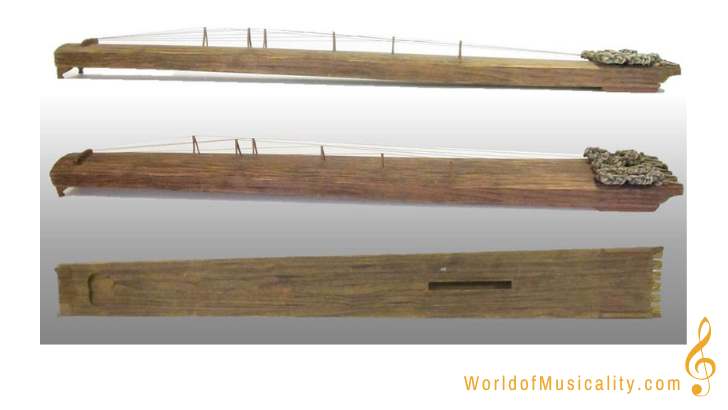
The Wagon is a Japanese string instrument that closely resembles a small zither. It features six silk strings stretched over a wooden body, and it is played using a delicate ivory plectrum. The body of the wagon is often made from kiri wood (Paulownia tomentosa), known for its light weight and good acoustic properties.
The sound produced by the wagon is gentle and ethereal, making it particularly suited for the serene settings of imperial court music and certain types of traditional Japanese rituals. Its tone is soft and resonant, creating an atmosphere of calm and refinement.
The wagon’s origins trace back to the Heian period (794-1185 AD), a time when it was predominantly used in gagaku, the classical music of the Japanese imperial court. Over the centuries, the wagon has maintained its status as a ceremonial instrument, often associated with aristocratic culture and rarely seen outside specific traditional contexts.
While there are no widely recognized famous musicians for the wagon due to its specialized use in court music, it continues to be played by gagaku musicians who are trained in this ancient art form, preserving its historical and cultural significance.
10. Gottan
A simple, rustic lute made of wood and covered with cat or dog skin, with three strings, used in folk music.
The Gottan is a traditional musical instrument with a simple yet charming design, often used in folk music. It resembles a small, rustic lute and is crafted from a single piece of wood, typically Japanese cedar or cypress, which forms both the body and the neck. The top of the Gottan is covered with cat or dog skin, which acts as the soundboard, and it has three strings made from silk or nylon.
The sound of the Gottan is mellow and warm, providing a soothing accompaniment to vocal melodies in folk songs. Its tone is less sharp than that of a guitar, giving it a distinctively soft, earthy quality that blends well in ensemble settings.
The Gottan’s origins are humble, believed to have been developed by farmers in rural areas of Japan as an affordable alternative to more elaborate string instruments like the shamisen. It has historically been used in informal settings, often played during local festivals and small gatherings. The Gottan is not as widely recognized in the grand spectrum of Japanese music as some other traditional instruments, and thus, there are no widely known significant musicians associated with it. Its role remains primarily within the folk traditions of various Japanese regions, symbolizing the musical creativity of everyday life.
Japanese Woodwind Instruments
11. Shakuhachi
A bamboo flute known for its deep, resonant sound, primarily used in Zen Buddhist meditation and classical folk music.
The Shakuhachi is a traditional Japanese flute made from a single piece of bamboo, featuring five holes—four on the front and one on the back. It ranges in length, but typically measures around 55 centimeters. The bamboo used is often “madake” bamboo, known for its thick walls and robust nature, which contribute to the instrument’s deep and resonant sound.
When played, the shakuhachi produces a range of sounds from soft, breathy whispers to strong, piercing notes. Its unique sound is highly expressive and can convey a wide range of emotions, making it suitable for both meditative and dynamic musical pieces.
Historically, the shakuhachi was introduced to Japan from China in the 7th century but underwent significant development in Japan. It became particularly associated with the Fuke sect of Zen Buddhism in the Edo period (1603-1868), where it was played by komusō monks as a form of meditation called “suizen” or blowing meditation. These monks were recognizable by their woven baskets worn on the head, using the shakuhachi both as a spiritual tool and as a means of alms collecting.
Significant musicians of the shakuhachi include Watazumi Doso Roshi and Goro Yamaguchi, both of whom were key figures in popularizing the instrument globally and in traditional Japanese music. Their mastery over the shakuhachi helped preserve its legacy and influence in world music.
12. Shinobue
A high-pitched bamboo flute that features prominently in traditional noh and kabuki theater performances, as well as in festive music.
The Shinobue is a traditional Japanese flute crafted from bamboo, cherished for its high-pitched and bright sound. This flute typically has seven holes—six on the top and one on the bottom—and comes in various lengths, influencing its pitch and the scale it can play. The shinobue is usually made from a specific type of bamboo that ensures the flute is both durable and capable of producing a clear, vibrant tone.
The sound of the shinobue is penetrating and can carry over long distances, which makes it especially popular in outdoor festivals and parades. Its clear tone is also favored in theatrical performances like noh and kabuki, where it accompanies dramatic scenes and enhances the emotional atmosphere.
The shinobue has a long history in Japanese culture, where it has been used not only in traditional arts but also in folk music, signifying its broad appeal and versatility. Its presence in festive settings often symbolizes joy and celebration.
While there are many notable shinobue players, one significant musician is Kohei Nishikawa. Nishikawa is known for his mastery and innovative techniques, which have helped modernize the shinobue’s role in contemporary music while respecting its traditional roots. His contributions have broadened the understanding and appreciation of this vibrant instrument.
13. Hichiriki
A double-reed woodwind instrument with a penetrating, nasal tone, widely used in gagaku, the ancient court music of Japan.
The hichiriki is a traditional Japanese double-reed woodwind instrument, essential in Gagaku, which is the classical court music of Japan. It is small, about 18 centimeters in length, and is often made from bamboo, though sometimes it uses other woods for different acoustic properties. The instrument has a tubular body with nine holes—seven on the front and two on the back—and is fitted with a double reed, which gives it a distinctive, penetrating sound that can be quite loud and nasal.
The sound of the hichiriki is often described as intense and emotional, capable of both mournful and joyous expressions, making it a powerful lead instrument in Gagaku ensembles. Its ability to convey profound emotions suits the ceremonial and often spiritual performances it accompanies.
Introduced from China as part of the cultural exchange along the Silk Road more than a thousand years ago, the hichiriki quickly became an integral part of Japanese imperial court music. It is not only a musical instrument but also a symbol of spiritual and cultural heritage in Japan.
Although there are fewer contemporary musicians dedicated exclusively to the hichiriki compared to other traditional Japanese instruments, those who do play it, like Hitomi Nakamura, continue to uphold and teach its traditional music styles and techniques, ensuring its continuation in Japanese cultural performances.
14. Ryuteki
A transverse bamboo flute used in gagaku, producing a clear, melodious sound that represents the voice of dragons, adding a mystical layer to performances.
The Ryuteki is a traditional Japanese transverse flute made primarily of bamboo. It is a key instrument in gagaku, the ancient imperial court music of Japan. Typically, the ryuteki is about 40 centimeters long and features seven finger holes—six on the top and one on the bottom. The bamboo used is carefully selected for its quality and sound properties, contributing to the flute’s clear and melodious tone.
The sound of the ryuteki is described as light and airy, often compared to the mythical voice of dragons, which is why it plays an essential role in gagaku performances that depict scenes involving these celestial creatures. Its music is intended to evoke a sense of ethereal beauty and is crucial in creating the atmospheric setting of gagaku.
The ryuteki’s history dates back to the Nara period (710-794 AD), when gagaku was formally adopted from Chinese and Korean influences. Over centuries, it has remained a staple in these ceremonial performances, preserved by imperial court musicians and handed down through generations.
While there are fewer famous ryuteki players compared to more mainstream instruments, one notable musician in the context of gagaku is Hideki Togi, who hails from a long line of gagaku musicians. Togi has been instrumental in introducing gagaku and the ryuteki to contemporary audiences, blending traditional sounds with modern music elements.
15. Nohkan
A small, high-pitched bamboo flute specifically crafted for noh theater, producing a distinctive sound that enhances the dramatic atmosphere of performances.
The Nohkan is a traditional Japanese flute made specifically for use in Noh theater, one of Japan’s oldest performing arts. Crafted from a single piece of bamboo, the Nohkan is relatively small and slender, featuring seven finger holes that allow for the production of various pitches. The bamboo used is typically smoked to increase durability and add a distinct coloration.
The sound of the Nohkan is high-pitched and somewhat piercing, designed to cut through the ambient sounds of a live Noh performance, where it accompanies slow, stylized movements and chanting. Its sound is essential for creating the ethereal and otherworldly atmosphere that Noh theater is known for.
Historically, the Nohkan’s origins are tied closely with the development of Noh theater during the 14th century. As Noh evolved, the Nohkan became an integral part of the music ensemble, playing a crucial role in conveying the emotional and narrative elements of the performances.
While there are not as many widely recognized solo artists for the Nohkan compared to other instruments, skilled Noh performers and certain families, such as the Kanze and Komparu, are renowned for their mastery of this instrument, passing down techniques through generations within the theater community.
16. Komabue
A small bamboo flute used in gagaku, similar to the ryuteki but with a softer tone, played in certain dances and songs within the court music ensemble.
The Komabue is a traditional Japanese flute made from bamboo, specifically designed for use in gagaku, the classical court music of Japan. It is a small transverse flute, shorter than other gagaku flutes like the ryuteki, measuring around 36 centimeters in length. The Komabue typically has six finger holes and one thumb hole, and it is crafted from a specific type of bamboo that gives it a clear and bright sound.
The sound of the Komabue is delicate and airy, contributing to the ethereal atmosphere required in gagaku performances. It is often used to accompany dances and songs that are part of the court music ensemble, adding subtle melodic lines that blend with other traditional instruments.
The Komabue’s history in Japanese culture extends back to the Nara period (710-794 AD), when gagaku was first introduced to the imperial court from Korea and China. Over the centuries, gagaku and its instruments like the Komabue have been preserved almost unchanged, maintaining a vital connection to Japan’s cultural heritage.
While there are no widely recognized soloists on the Komabue due to its specific role in ensemble settings, musicians trained in gagaku are skilled in multiple instruments, including the Komabue, preserving its traditional techniques and sounds.
17. Kagurabue
A bamboo flute used in Shinto religious ceremonies, particularly kagura, which is music and dance meant to entertain deities during festivals.
The Kagurabue is a traditional Japanese bamboo flute used specifically in Shinto religious ceremonies called Kagura, which are performances intended to entertain deities. This flute is typically made from a single piece of bamboo, with seven holes that allow it to produce a variety of pitches. The Kagurabue is distinctively longer than other traditional Japanese flutes, contributing to its deeper and mellower sound compared to the sharper tones of instruments like the shinobue.
The sound of the Kagurabue is serene and ethereal, designed to evoke a spiritual atmosphere during religious rituals. Its melodies are often simple yet profound, reflecting the sacred nature of the ceremonies it accompanies.
Kagura music, where the Kagurabue is primarily used, is one of the oldest performing arts in Japan, believed to have divine origins according to Shinto mythology. The music and dance performed in Kagura are meant to convey mythical stories and to express gratitude to the gods, with the Kagurabue playing a crucial role in setting the ceremonial tone.
While there are no widely recognized celebrity musicians associated specifically with the Kagurabue due to its ceremonial use, the instrument is revered among practitioners of Shinto music and is considered an essential part of the spiritual and cultural heritage of Japan.
18. Yokobue
An umbrella term that includes several types of transverse flutes like the shinobue and ryuteki, used across various traditional Japanese musical contexts.
The yokobue is a category of traditional Japanese transverse flutes, made primarily from bamboo. These flutes vary in size and tone, catering to different musical genres and cultural functions within Japan. Common types of yokobue include the shinobue and the ryuteki, each crafted to produce specific sound qualities suited to their performance contexts.
The yokobue typically produces a clear, high-pitched sound, though the tone can vary from bright and lively in festival music to more subdued and melodic in theatrical performances. Its sound is crucial in enhancing the emotional atmosphere in various forms of traditional Japanese arts.
The history of the yokobue stretches back centuries in Japan, with its use in both court music and popular folk traditions. In gagaku (ancient imperial court music), instruments like the ryuteki carry significant roles, while in local festivals, instruments such as the shinobue are more commonly heard, integral to the festive music that accompanies traditional dances and parades.
Though there are many skilled yokobue musicians, one notable figure is Aoki Reibo, a master of the shinobue, who is celebrated for his contributions to traditional Japanese music and for bringing the sound of the yokobue to international audiences through his performances and recordings. His work has helped preserve the rich heritage of the yokobue and inspired a new generation of musicians.
19. Hotchiku
A less refined form of the shakuhachi, made from root-end bamboo, producing a raw and ethereal sound, often used in spiritual and solo performances.
The Hotchiku is a unique and ancient type of Japanese bamboo flute closely related to the shakuhachi. It is crafted from root-end bamboo, retaining much of the natural characteristics of the bamboo, such as knots and a rugged surface. This construction gives the hotchiku a raw and natural appearance and contributes to its deep, breathy, and ethereal sound, which is often described as haunting or meditative.
Unlike the shakuhachi, which is finely tuned and polished, the hotchiku is typically not lacquered or tuned to any standard musical scale. This gives each hotchiku a distinctive voice, depending on the bamboo used. The instrument generally has four front holes and one back hole for playing.
The hotchiku’s origins are deeply intertwined with Zen Buddhism, similar to the shakuhachi. It was used as a spiritual tool for meditation and was less concerned with musical performance than with the breath (suizen) used to achieve enlightenment.
One significant musician associated with the hotchiku is Watazumi Doso Roshi, a Zen Buddhist priest and master of the instrument. He was renowned for his profound and spiritual approach to playing, which emphasized the natural and unrefined sounds that the hotchiku could produce, aligning closely with Zen principles.
Traditional Japanese Percussion Instruments
20. Taiko
Taiko – A broad range of Japanese drums, known for their deep, resonant sounds and used in ensemble performances in festivals and concerts.
The Taiko is a traditional Japanese drum that varies widely in size, but all share a common construction: a cylindrical body with drumheads made of animal skin, usually cowhide, stretched over both ends. The body itself is typically made from hollowed-out wood, which helps to produce its deep, resonant sound that can vary from sharp cracks to booming echoes, depending on the size and manner of playing.
Taiko drums have been a part of Japanese culture since the 6th century, used initially in religious ceremonies and wartime to motivate troops. Over time, their use expanded into festivals, theatrical performances, and other community gatherings, becoming a symbol of cultural identity and community spirit in Japan.
Today, Taiko is not only a musical instrument but also a part of a dynamic performance art, involving choreographed movements that are as much a visual spectacle as a musical act. Significant musicians like Daihachi Oguchi and Sukeroku Daiko have been instrumental in popularizing modern Taiko ensemble performances, transforming these drums into a global phenomenon that symbolizes Japanese tradition and musical innovation.
21. Tsuzumi
A small hourglass-shaped drum that is held in the hand and played with bare hands. It’s often used in Noh and Kabuki theater.
The Tsuzumi is a traditional Japanese drum that plays a vital role in both Noh and Kabuki theater music. It features an hourglass shape and is typically held and played with the hands. The body of the Tsuzumi is made from cherry or mulberry wood, which gives it a lightweight yet sturdy frame. The drumheads on either side are made from horsehide, and they are attached to the wooden body with silk cords. These cords can be squeezed and adjusted while playing to change the pitch of the drum, adding a dynamic element to performances.
The sound of the Tsuzumi is sharp and high-pitched, capable of producing a variety of tones depending on how it is hit and how the silk cords are manipulated. Its distinctive sound is often used to enhance the emotional and dramatic moments in theatrical performances.
Introduced from China around the 7th century, the Tsuzumi has been an integral part of Japanese performing arts, symbolizing rhythmic and dramatic expression. While there are no widely known solo musicians for the Tsuzumi, its players are highly respected within the traditional music and theater communities, mastering the intricate techniques required to bring its sound to life on stage.
22. Shime-daiko
A smaller, high-pitched drum with a tightened skin, used in both theatrical music and as a rhythmic accompaniment in ensemble settings.
The Shime-daiko is a traditional Japanese drum known for its compact size and high-pitched sound. This drum features a cylindrical body, usually made from wood, with animal skin—commonly horse or cowhide—stretched tightly across both ends. The skins are secured and tensioned using ropes or bolts, which can be adjusted to alter the drum’s pitch. This adjustability allows musicians to produce a sharp, clear tone that cuts through other sounds in ensemble performances.
Shime-daiko is often used in a variety of Japanese musical forms, from folk music and religious ceremonies to theatrical performances such as Kabuki and Noh. Its precise and crisp sound makes it ideal for setting rhythms and providing rhythmic accompaniment to dances and dramatic scenes.
The instrument has been part of Japanese culture for centuries, integral to both celebratory and solemn occasions. It is especially prominent during festivals, where it’s played to energize crowds and lead parades.
While there are no widely recognized soloists on the Shime-daiko, as it is typically part of an ensemble, many skilled taiko performers are proficient with it, contributing to its enduring presence in traditional and contemporary Japanese music.
23. O-daiko
A large drum often used as a centerpiece in taiko performances, known for its powerful sound and visual impact.
The O-daiko is a large, powerful drum that stands as a prominent feature in traditional Japanese taiko drumming ensembles. Physically, it is impressive due to its size, which can be as large as a meter in diameter, making it one of the largest drums used in Japanese music. The body of the O-daiko is typically made from a hollowed-out tree trunk, often Japanese cedar or zelkova, and the drumheads are made from cowhide, stretched and nailed over both ends of the drum.
The sound of the O-daiko is deep and resonant, capable of producing thunderous booms that can be felt as much as heard. This makes it a central piece in performances, providing the foundational beats that drive the rhythm of the ensemble.
Historically, the O-daiko has been used in religious ceremonies and festivals, intended to communicate strength and to invoke a spiritual presence. It is also a symbol of endurance and unity in Japanese culture.
While there are many skilled taiko players, Eitetsu Hayashi is a notable musician who has gained international recognition for his O-daiko performances, elevating the art form on a global stage.
24. Kotsuzumi
Another small hand-held drum similar to tsuzumi, used in traditional Japanese theater, producing a higher-pitched sound.
The Kotsuzumi, also known as the shoulder drum, is a small traditional Japanese hand drum used primarily in Noh and Kabuki theater. It is shaped like an hourglass and held in the hand, typically played by striking the drumhead with the fingers. The drum’s body is made from cherry wood, which is lightweight and durable, while the drumhead is crafted from horsehide, tightly stretched and secured with cords. This construction allows the player to adjust the tension and pitch by squeezing the cords while playing.
The Kotsuzumi produces a sharp, high-pitched sound that can vary in pitch and intensity, depending on how the player manipulates the cords. Its distinctive tone is crucial for setting the emotional tone in theatrical performances, complementing the dramatic action on stage.
Introduced to Japan from China around the 7th century, the Kotsuzumi has become an integral part of traditional Japanese performing arts. It is not only used in theater but also in rituals and dances, playing a key role in the preservation of Japan’s cultural heritage.
While there are no widely recognized musicians associated exclusively with the Kotsuzumi, various skilled Noh and Kabuki performers have mastered this instrument as part of their artistry, passing down techniques through generations.
25. Okawa
A shallow drum with a wooden body that is used in traditional Japanese music, especially in ensembles accompanying dance.
The Okawa is a traditional Japanese drum that features a shallow, circular body made primarily from wood, with a drumhead typically crafted from animal skin, such as horse or cowhide. This drum is unique because of its shallow depth, which gives it a distinct, crisp sound that is less resonant but sharper than deeper-bodied drums.
Traditionally, the Okawa is used in Japanese musical ensembles that accompany classical dances and theatrical performances. Its sound is particularly effective in providing rhythmic patterns that enhance the performance’s dramatic and emotional impact. The drum is usually played with the hands or light drumsticks, depending on the specific requirements of the performance.
The Okawa has been a part of traditional Japanese music for centuries, finding its place in both noh and kabuki theatre as well as in various festival music settings. Although it may not be as prominently featured as the larger taiko drums, its role is essential in creating the nuanced layers of Japanese percussion music.
Significant musicians specifically renowned for playing the Okawa are less common, as it is typically part of a larger ensemble, but it remains an integral tool for traditional percussionists in classical Japanese music settings.
26. Hyoshigi
Wooden clappers used to mark time or provide rhythmic accompaniment in theater and storytelling.
The Hyoshigi is a traditional Japanese percussion instrument primarily used to keep rhythm and signal timing in various forms of performance. Technically, it consists of two pieces of hardwood, such as oak or magnolia, carved into blocks and connected by a short rope. Players hold a block in each hand and strike them together to produce a sharp, clacking sound. The simplicity of the hyoshigi allows for precise control over rhythm and tempo.
Hyoshigi are most commonly heard in Kabuki and Noh theaters where they serve as auditory cues for performers and audiences alike, marking the beginning and end of scenes or emphasizing dramatic moments. They are also used in storytelling and folk music, particularly in rural areas where their clear tone can carry over long distances.
While there aren’t specific famous musicians known primarily for playing the hyoshigi, it is a crucial tool for many traditional Japanese music ensembles and theatrical troupes. Its role in performances is often foundational, as it helps to maintain the pace and flow of the presentation, ensuring that all performers are synchronized in their timing and expression.
27. Uchiwa Daiko
A fan-shaped drum that is typically used in folk music and festivals, played with a light striking motion.
The Uchiwa Daiko is a traditional Japanese drum that resembles a handheld fan, which gives it its name—’uchiwa’ means ‘fan’ in Japanese.
This drum consists of a circular frame made of wood, over which a piece of animal skin, typically cowhide, is stretched to form the drumhead. The frame is often decorated with bright, colorful patterns, adding a visual element to its rhythmic role.
The sound produced by the Uchiwa-daiko is sharp and resonant, capable of cutting through the noise of large festivals and gatherings where it is commonly played. The drum is played with a light striking motion using a drumstick, allowing for rapid rhythmic patterns that energize and animate the atmosphere.
Historically, the Uchiwa-daiko has been used in Japanese folk music, particularly at festivals and street parades. Its portability and distinctive sound make it perfect for outdoor performances where it accompanies dances and celebratory processions. Unlike some traditional Japanese instruments, the Uchiwa-daiko does not have any well-known musicians specifically associated with it, as it is typically played by community members rather than professional musicians in ensemble settings, emphasizing its role in communal and festive contexts.
28. Suzu
A type of bell or a set of small bells that are shaken, used in both Shinto rituals and as part of the musical ensemble in traditional performances.
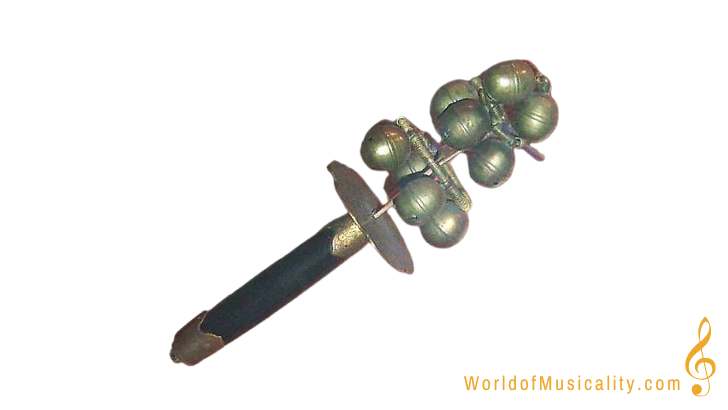
The Suzu is a traditional Japanese percussion instrument, essentially a set of small, round bells made from metal, often bronze or brass. Each bell is typically spherical, containing a small metal ball that creates a clear, high-pitched ringing sound when shaken. Suzu can range from a single bell to a large cluster of bells strung together on a handle or a piece of cord.
Historically, the Suzu has been used in various Japanese cultural and religious contexts. In Shinto rituals, these bells are used to ward off evil spirits and purify the area, making them integral to ceremonial practices. They are also used in traditional Japanese music and dance performances, adding a delicate, tinkling sound that complements the other instruments and enhances the overall auditory experience.
While there are no specific well-known musicians associated with the Suzu, as it is typically part of an ensemble rather than a solo instrument, its role in traditional performances and ceremonies remains crucial. The sound of Suzu is often associated with spiritual and festive occasions, making it a symbol of joy and sacredness in Japanese culture.
29. Dengaku
Wooden sticks used in folk music, especially during dance performances, contributing to rhythmic patterns.
Dengaku, traditionally known in Japan as ritual music and dance instruments, are simple yet integral wooden percussion sticks. They are primarily crafted from hardwood, which ensures durability and a clear, crisp sound when struck. The sticks are typically about the length of a forearm, making them easy to handle, especially during vigorous dance performances.
The sound produced by dengaku sticks is sharp and rhythmic, designed to maintain and enhance the tempo of dance and musical performances. Their simplicity allows for robust playing, which is crucial during lively festivals and ceremonies.
Dengaku originated from agricultural rituals in rural Japan, where they were played to entertain gods and spirits, hoping to secure a bountiful harvest. Over time, their use expanded into more formal settings, becoming a staple in traditional Japanese noh and kabuki theatre, where they helped to keep rhythm and add aural texture to performances.
While there are no widely recognized musicians known specifically for their mastery of dengaku sticks, these instruments are celebrated for their communal and cultural significance, often played by ensemble members rather than soloists, emphasizing their role in group performances and cultural festivities.
These instruments contribute significantly to the dynamic and diverse percussion landscape of traditional Japanese music, each adding unique sounds and rhythms to the rich tapestry of Japan’s musical heritage.
As we conclude our exploration of traditional Japanese musical instruments, we’ve barely scratched the surface of Japan’s rich musical heritage.
From the thunderous beats of taiko drums to the delicate melodies of the koto, each instrument carries its own story and significance.
To delve deeper into this fascinating world, consider further research and exploration either through the links below.

